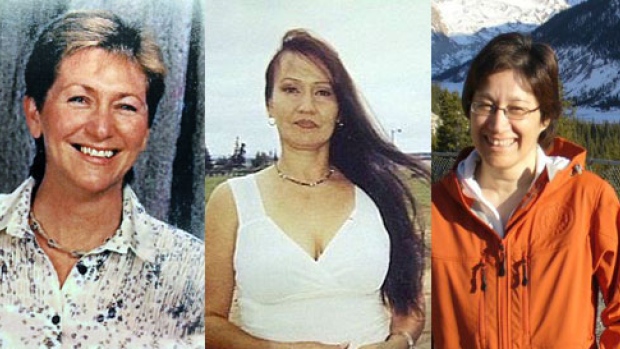Sharon Ann Kinequon, Dianne Martell, and Debbie Eisenhut were all killed as they left their partners
By Bonnie Allen, CBC News Posted: Apr 25, 2016 9:57 AM CT Last Updated: Apr 25, 2016 9:57 AM CT
A social worker, a law student, and a conservationist.
Three Saskatchewan women who were killed by their intimate partners in homicide-suicides in the past five years whose stories have gone untold so far.
What did they all have in common?
Family and friends say they were leaving their partner when the situation turned deadly.
Sharon Ann Kinequon, 48, worked as a social worker for Saskatchewan's Ministry of Social Services in Prince Albert and often helped children escape violence in the home. Yet, she wasn't immune to domestic violence herself.
"She was quite a special person," her brother, Chester Kinequon, told CBC. Eight siblings in the family had attended residential school and struggled with addictions issues.
"Sharon fought through it all," Chester said, boasting that his sister had completed a double Bachelors degree in Native Studies and social work so she could help other Aboriginal people with their healing.
So when Sharon's common law spouse, Bobby Nippi, another residential school survivor, began drinking heavily, the mother-of-three tried to stick it out and help him. Chester says his sister called police to intervene on at least one occasion.
In January 2015, she was preparing to leave the relationship and had even found a new place to live, family members say, but something went horribly and tragically wrong in the process.
On January 24, Melfort RCMP reported a woman, 48, and man, 46, had died in an apparent murder-suicide. The coroner's office has not completed its report.
From the start of their relationship, Dianne Martell's family suspected that her new husband, Blair Ilg, was trying to control and isolate her.
"It seemed like I could never talk to her privately," Dianne's sister, Yvonne Martell, said. Whether she visited Dianne in person or simply called her on the telephone, Yvonne says Ilg would sit next to Dianne and monitor their conversations.
The couple moved from Saskatoon to Prince Albert, where they lived in Ilg's parents' basement suite.
Family members say Martell was preparing to leave her husband three months before her death — but then, for whatever reason, she stayed.
Domestic violence experts say a woman leaves an abusive partner, on average, seven to eight times before she leaves for good.
In February 2012, family members say - once again - Martell seemed staged to leave her husband.
On February 19, a violent argument erupted in their home in Prince Albert. Martell was reportedly heard screaming, "He's going to kill me."
A coroner's report confirms Ilg shot his wife before turning the gun on himself.
In March 2011, Debbie Eisenhut, 56, had a plan to leave her girlfriend, Colleen Cote, 51, whom she lived with on a farm near Glaslyn, Sask.
Eisenhut, a passionate nature lover and conservationist, worked for the Ministry of Environment with Cote at Battlefords Provincial Park and the couple had dated for about two years.
Friends say Eisenhut had trepidation about leaving Cote, but it wasn't her own safety that worried her.
Cote had reportedly attempted suicide after a previous relationship ended.
Those who knew about Cote's history say they didn't realize a prior suicide attempt is a red flag common to people who kill family members.
Eisenhut had a plan to leave and a place to go.
Her friends say she was a strong and resourceful woman. She raised her son as a single mother and worked several jobs. She was also, many said, a kindhearted person who would give the shirt off her back to help others.
The night before Eisenhut was set to leave, things turned deadly.
Cote shot Eisenhut, then committed suicide by carbon monoxide poisoning.
RCMP found their bodies two days later on March 6, 2011 and the coroner ruled it a homicide-suicide.
Red Flags
A pending or recent separation is one of the most common contributing factors to domestic homicides.
An expert panel in Ontario that reviews every killing by an intimate partner or ex-partner has concluded 75 per cent of the killings are "predictable and potentially preventable."
It has compiled a list of 39 risk factors and determined that a person with seven or more well-known risk factors is more likely to kill a family member. Common red flags include a pending or recent separation, a history of domestic violence, escalating violence, obsessive behaviour, depression and prior death threats.
Experts make several recommendations to safely leave a relationship. They include:
Recognize the risk (i.e. has your partner made death or suicide threats? does your partner own a gun?)
Develop a safety plan (i.e. identify a shelter or safe place, compile your documents)
Leave first. Do not inform your partner of your intentions.
Build a support network of people to help you.

From left, Debbie Eisenhut, 56, Dianne Martell, 44, and Sharon Ann Kinequon, 49, were all victims in murder-suicide cases. (Facebook/Submitted to CBC)



